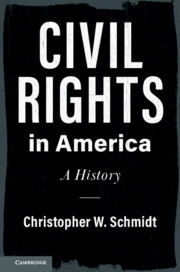Book contents
- Civil Rights in America
- Cambridge Studies on Civil Rights and Civil Liberties
- Civil Rights in America
- Copyright page
- Dedication
- Epigraph
- Contents
- Introduction
- 1 The Birth of Civil Rights – Reconstruction
- 2 The Transformation of Civil Rights – The Jim Crow Years
- 3 Civil Rights Reborn – The 1940s and 1950s
- 4 Beyond Civil Rights – The 1960s
- 5 Getting Right with the Civil Rights Movement
- 6 Civil Rights Everywhere
- Conclusion
- Acknowledgments
- Notes
- Index
4 - Beyond Civil Rights – The 1960s
Civil Rights vs. Human Rights
Published online by Cambridge University Press: 03 December 2020
- Civil Rights in America
- Cambridge Studies on Civil Rights and Civil Liberties
- Civil Rights in America
- Copyright page
- Dedication
- Epigraph
- Contents
- Introduction
- 1 The Birth of Civil Rights – Reconstruction
- 2 The Transformation of Civil Rights – The Jim Crow Years
- 3 Civil Rights Reborn – The 1940s and 1950s
- 4 Beyond Civil Rights – The 1960s
- 5 Getting Right with the Civil Rights Movement
- 6 Civil Rights Everywhere
- Conclusion
- Acknowledgments
- Notes
- Index
Summary
Few people played more significant a role in the civil rights movement than Bayard Rustin. An openly gay man with a history of connections to radical groups, this lifelong peace and racial justice activist often had to operate in the movement’s background. He nonetheless left a remarkable legacy. Rustin helped found two major racial justice organizations – the Congress of Racial Equality (CORE) and the Southern Christian Leadership Conference (SCLC). He also was the organizational mastermind behind many of the movement’s major protest efforts, including the 1963 March on Washington.
- Type
- Chapter
- Information
- Civil Rights in AmericaA History, pp. 76 - 97Publisher: Cambridge University PressPrint publication year: 2020

